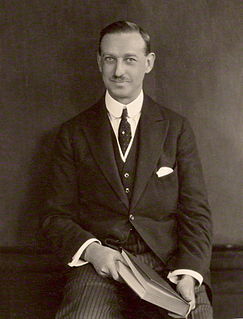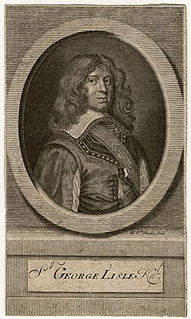Related Research Articles

Earl of Chesterfield, in the County of Derby, was a title in the Peerage of England. It was created in 1628 for Philip Stanhope, 1st Baron Stanhope. He had already been created Baron Stanhope, of Shelford in the County of Nottingham, in 1616, also in the Peerage of England. Stanhope's youngest son the Hon. Alexander Stanhope was the father of James Stanhope, 1st Earl Stanhope while his half-brother Sir John Stanhope of Elvaston was the great-grandfather of William Stanhope, 1st Earl of Harrington.

Lieutenant-General James FitzThomas Butler, 1st Duke of Ormond, KG, PC, was an Irish statesman and soldier, known as Earl of Ormond from 1634 to 1642 and Marquess of Ormond from 1642 to 1661. Following the failure of the senior line of the Butler family, he was the second representative of the Kilcash branch to inherit the earldom.

Philip Dormer Stanhope, 4th Earl of Chesterfield, was a British statesman, diplomat, and man of letters, and an acclaimed wit of his time.

The Irish Confederate Wars, also called the Eleven Years' War, took place in Ireland between 1641 and 1653. It was the Irish theatre of the Wars of the Three Kingdoms, a series of civil wars in the kingdoms of Ireland, England and Scotland – all ruled by Charles I. The conflict had political, religious and ethnic aspects and was fought over governance, land ownership, religious freedom and religious discrimination. The main issues were whether Irish Catholics or British Protestants held most political power and owned most of the land, and whether Ireland would be a self-governing kingdom under Charles I or subordinate to the parliament in England. It was the most destructive conflict in Irish history and caused 200,000–600,000 deaths from fighting as well as war-related famine and disease.
Earl Stanhope was a title in the Peerage of Great Britain (1718–1967).

Sir John Gell, 1st Baronet was a British landowner from Derbyshire who acted as local Parliamentarian commander for most of the First English Civil War before resigning in May 1646. He was notorious for parading the body of his Royalist opponent through Derby after the Battle of Hopton Heath in March 1643.

James Richard Stanhope, 7th Earl Stanhope,, styled Viscount Mahon until 1905, and known as the Earl Stanhope from 1905 until his death, was a British Conservative politician.
Henry Hastings, 1st Baron Loughborough was an English Royalist army commander in the Midlands during the English Civil War.
Philip Stanhope, 1st Earl of Chesterfield was an English nobleman, aristocrat and royalist, who was created the first Earl of Chesterfield by King Charles I in 1628.
Michael Stanhope was born at Shelford Manor, the son of Philip Stanhope, 1st Earl of Chesterfield and his wife Catherine, daughter of Lord Hastings. Colonel Stanhope was in charge of the Royalist forces at the 1648 battle at Willoughby Field, Nottinghamshire, where he was killed. After the battle he was buried among his men in Willoughby church. A monument was erected to him and his men.

Ferdinando Stanhope, younger son of Philip Stanhope, 1st Earl of Chesterfield, was Member of Parliament for Tamworth from 1640 to 1643. He served in the Royalist army during the First English Civil War and was killed in a skirmish near West Bridgford.
Philip Stanhope may refer to:

Sir George Lisle was a professional soldier from London who briefly served in the later stages of the Eighty and Thirty Years War, then fought for the Royalists during the Wars of the Three Kingdoms. Captured at Colchester in August 1648, he was condemned to death by a Parliamentarian court martial and executed by firing squad along with his colleague Charles Lucas.

Shelford Priory is a former Augustinian Monastery located in the village of Shelford, Nottinghamshire, United Kingdom. The priory was founded by Ralph Haunselyn around 1160–80 and dissolved in 1536. Little remains of the original priory. Following dissolution it was granted to Michael Stanhope, and c.1600 Shelford Manor was constructed on the site. The manor was fortified and then partially destroyed during the English Civil War. The house was reconstructed c.1678, however, it was altered in the 18th and 19th centuries. It is now known as Shelford Manor and is a private residence.
Sir John Stanhope was an English knight and landowner, and father of Philip Stanhope, 1st Earl of Chesterfield.
Henry Stanhope, Lord Stanhope KB, known as Sir Henry Stanhope until 1628, was an English nobleman and politician.
Arthur Stanhope was an English politician who sat in the House of Commons between 1660 and 1679.
Francis Hastings, Lord Hastings was the son of George Hastings, 4th Earl of Huntingdon and Dorothy Port. He married Sarah Harington, daughter of Sir James Harington and Lucy Sydney. They had five children:

Katherine Stanhope, Countess of Chesterfield (1609–1667) was an English courtier who was the governess and confidante of Mary, Princess Royal and Princess of Orange, and the first woman to hold the office of Postmaster General of England.
The Storming of Shelford House was a confrontation of the English Civil War that took place from 1 to 3 November 1645. The Parliamentarian force of Colonel-General Sydnam Poyntz attacked the Royalist outpost of Shelford House, which was one of a group of strongholds defending the strategically important town of Newark-on-Trent. The house, owned by Philip Stanhope, 1st Earl of Chesterfield and controlled by his son Sir Philip Stanhope, and made up of mostly Catholic soldiers, was overwhelmed by the Parliamentarian force after calls for submission were turned down by Stanhope. The majority of the defenders were killed in the resulting sack by the Parliamentarians, commanded by Colonel John Hutchinson, and the house was then burned to the ground. Stanhope died soon afterwards from injuries he sustained in the attack.
References
- ↑ Collin's Peerage of England by Sir Egerton Brydges, K.J.: in nine volumes: VOL. III 1812: Earl of Chesterfield: pp. 422–423. In the list of sons he comes in after the ninth, even though in the text a few lines further on, he is described as fifth son. In the list itself, William is described as Fifth.
- ↑ Appleby 2020, pp. 286–290.